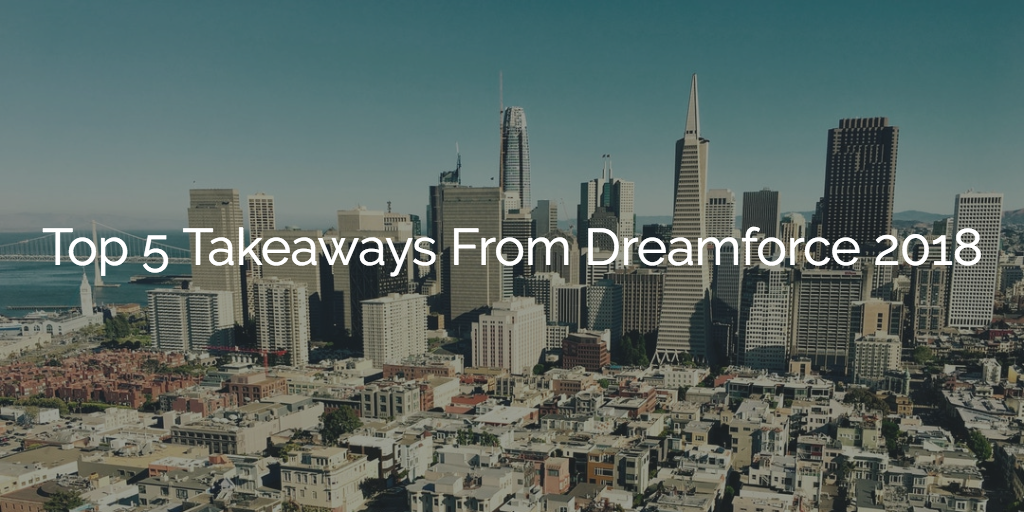Another Dreamforce has come and gone. Have you caught your breath yet? Are your ears still ringing from that Metallica show?
When it comes to the world’s biggest, wildest, busiest SaaS conference, it can sometimes seem like the longest-lasting takeaways are the tote bags full of swag; there’s just so much going on, so many people to meet, and new strategies to put into practice. It’s difficult to parse it all at once over four breathless days even as you’re running around San Francisco between sessions and meetings and booths and kiosks.
If you asked any one of the 171,000 attendees what their biggest takeaway was, you may get 171,000 different answers—that’s the nature of the beast. That’s why we wanted to collect our team’s top learnings into a digestible blog post. Let’s break down the chaos into five bite-sized chunks.
1. You need a 360-degree view of your customers
One of Salesforce’s biggest product announcements was Salesforce Customer 360, based on tech they acquired when they bought Mulesoft. Mulesoft has been a longtime customer of ours. They recognized early on the need to make customer data actionable no matter how that data is brought together.
Salesforce Customer 360 obviously isn’t what most people think of when they imagine a true comprehensive customer view—it’s definitely more of an admin tool for connecting various Salesforce clouds. But those words kept popping up in sessions and conversations.
It’s clear that customer relationships are becoming more complex and dynamic, and a modern Customer 360 is necessary to provide a complete picture of each one. I highly encourage you to check out our CEO’s latest post on what a forward-looking Customer 360 strategy looks like.
2. Data orchestration is a top priority
I was talking to our CIO, and his Dreamforce experience was marked by dozens of conversations about the role of the IT leader in 2019 and beyond. He’s seeing the CIO position continue its evolution away from a reactive, tactical “firefighting” position to a much more strategic voice.
CIOs are thinking less about how to keep plates spinning with their internal teams and more about how to grow revenues and capitalize on opportunities to improve efficiency. A big part of that evolution is data orchestration.
Whether it’s a merger and acquisition situation, a digital transformation project, or any other type of companywide change management, getting disparate data to work seamlessly together across teams is becoming a top priority for more and more CIOs. Get his advice on migration strategy in this post!
3. Customer Experience requires end-to-end coordination
At Dreamforce, it seemed as if the terms “Digital Transformation” and “Customer-Centricity” were used almost interchangeably. And it makes sense when you consider the digital transformation imperative—digital disruption has made the customer the scarcest resource in the economic equation. Deeper relationships protect that resource better than any other strategy, and digital data is what makes those deep relationships achievable at scale.
But like any healthy relationship, it’s all about communication. All it takes is one bad interaction from between two or more human beings on both sides to set the customer on the path toward churn. And they don’t even necessarily need to be bad touchpoints; just uncoordinated. In business, two rights can make a wrong!
How to achieve great customer experiences was the subject of many sessions, and it’s clear that it starts with an end-to-end, coordinated process.
Had such a great time speaking with @Tiffani_Bova on a # DF18 stage about how #CustomerSuccess is the combined result of customer outcomes and great #CX. Thank you for having me @Dreamforce! pic.twitter.com/P5kTrFm4cx
— Nick Mehta (@nrmehta) September 27, 2018
4. Strategic partnerships are crucial
Maybe the two biggest announcements Salesforce made was a new partnership with Apple and an expanded one with Amazon Web Services. It’s cool to see competition driving these mega-companies to more cooperation and integration. The users definitely benefit!
Gainsight is strongly invested in growing and expanding our partner ecosystem as well. These kinds of ecosystems help companies respond to growing customer demands way more agilely than any single company on its own.
It’s all about expanding your value chain without adding complexity. Partners help you do that with very low investment. You pass that value on to the customer, everybody wins!
5. The time to focus on diversity is yesterday
This @trailhead keynote at @Dreamforce is amazing. Real talk with @LeahBMH about the state of tech and diversity. And how we can change the ratio with the BAM (Be A Multiplier) program. This is why I work at @Salesforce #DF18 pic.twitter.com/bMMhCxR75X
— Marc Baizman (@mbaizman) September 27, 2018
I saved the most important for last. There was an extremely deliberate and pervasive emphasis on active inclusivity at Dreamforce, and it underscores that even with Einstein and AI and cool new ways to make stuff and sell stuff, the most important thing we can take away from yesterday is a heavy sense of responsibility.
Inequality in the workplace and in our society starts with me. I make choices every day—to ignore or not ignore microaggressions, to use or not use inclusive language, to hire or not hire diverse candidates, to pay some people less than others, to speak up for marginalized people or just let it be. The status quo is inequal, but it’s reinforced by our decisions.
It’s time to take a more active role in creating a more just country, and that needs to start yesterday.
